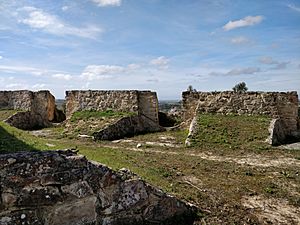Battle of Sobral facts for kids
Quick facts for kids Battle of Sobral |
|||||||
|---|---|---|---|---|---|---|---|
| Part of the Peninsular War | |||||||
 View of gun emplacements at the Fort of Olheiros, Torres Vedras |
|||||||
|
|||||||
| Belligerents | |||||||
| Commanders and leaders | |||||||
| Units involved | |||||||
| Strength | |||||||
| 16,939 | 1st Division: 7,053 4th Division: 7,400 Total: 14,453 |
||||||
| Casualties and losses | |||||||
| 13 October: 157 14 October: 120 |
13 October: 139 14 October: 67 |
||||||
The Battle of Sobral happened on October 13–14, 1810. It was a key moment in the Peninsular War. During this battle, the French army, led by André Masséna, tried to test the strong defenses known as the Lines of Torres Vedras. These defenses were built by Wellington's British and Portuguese forces. The battle showed how strong Wellington's defenses were. Masséna's army eventually had to retreat in March 1811. Many French soldiers died from hunger and sickness because of a strategy called scorched earth.
Contents
Background to the Battle
The Peninsular War began in Portugal in 1807. It was a long conflict that lasted until 1814. In September 1810, French General Masséna made his third attempt to take over Portugal. He led an army of about 65,000 soldiers. They fought in the Battle of Bussaco, but Wellington decided to pull his army back. He moved them southwards, deeper into Portugal.
Wellington's Clever Plan
The French army, with about 61,000 men, chased Wellington. But they found the land empty and barren. Portuguese farmers had left their homes. They had destroyed all the food they couldn't carry. They also ruined anything else that might help the French army. This was part of a strategy called the scorched earth policy. It meant burning or destroying everything useful.
The Secret Defenses
On October 11, 1810, Masséna's army finally found Wellington. He was behind an almost unbeatable defensive position. These were the Lines of Torres Vedras. They were a series of forts and other military defenses. These lines were built in total secrecy. Their purpose was to protect the only way to Lisbon, the capital city, from the north.
The Battle at Sobral
The fighting at Sobral involved Jean-Andoche Junot's VIII Corps of the French army. They fought on both days of the battle.
First Day of Fighting
On October 13, the French soldiers pushed back the skirmish line. This was the front line of soldiers from Lowry Cole's 4th British Infantry Division. It was a tough start for the British and Portuguese.
Second Day of Fighting
The next day, October 14, Junot's troops managed to capture an outpost. This outpost belonged to Brent Spencer's 1st British Infantry Division. However, the British quickly fought back. They launched a strong counterattack. They managed to kick the French out of the position they had just taken.
What Happened After
After these clashes, Masséna realized something important. Wellington's defensive lines were simply too strong to break through. He decided it was best to wait for more soldiers to arrive.
Lack of Supplies and Retreat
However, the French army soon faced a big problem. There was not enough food for the soldiers. There was also not enough fodder for their horses. This was because of Wellington's scorched earth policy. Masséna was forced to retreat northwards. This retreat began on the night of November 14/15, 1810. He needed to find an area that had not been stripped bare.
A Harsh Winter and More Losses
The French army managed to hold on through February. But the Iberian peninsula had one of its coldest winters ever. Eventually, starvation and diseases became a huge problem. Masséna had no choice. He ordered a full retreat at the beginning of March 1811. By this time, he had lost another 21,000 soldiers.
The Third Portuguese campaign continued after this. The next major event was the Battle of Sabugal.
See also
- Fort of Alqueidão
- List of forts of the Lines of Torres Vedras
- Attrition warfare against Napoleon

